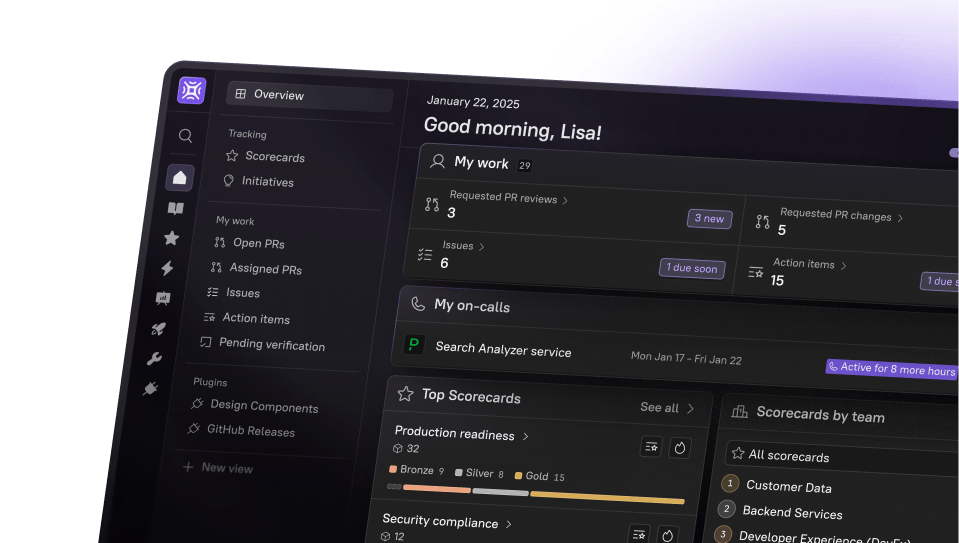
This guide was last updated on August 5, 2025.
Comparison Guide
What to expect?
This comparison is broken out not just by feature or function, but by the steps required to successfully roll out an IDP and affect material improvements to your engineering organization.
For each of these steps, the comparison document provides an overview of why it matters, the requirement set, a TL;DR, and a detailed breakdown.
Step 1
Import your data & build your catalog
Step 2
Define ownership
Step 3
Create your first 3 Scorecards
Step 4
Deliver your first self-service experience
Step 5
Extend the IDP and make it your own
Step 6
Run an org wide initiative
Step 7
Measure & improve
Step 8
Make your engineering team happy
Note from the Founders
When we set out to build Cortex, we were solving a problem that we faced as engineers, and our personal product philosophy along with the feedback from users who felt Cortex was the right fit for them are the things that drive how our product works.
We’re tired of B2B SaaS compare pages that are so horribly biased that don’t actually serve any purpose. It’s always the same – one column with green checks, and the other with vague indicators of missing features that verge on being outright lies. The reality is that competing products are similar in many ways, but different too, having strengths and weaknesses depending on what the user cares about.
We hope that this comparison page is meaningful and actually helps you decide which product is the right one for you – and of course, we hope it’s Cortex!
Cortex Founders
Cortex vs OpsLevel: Comparison overview
We’ve broken down the comparison by the steps involved in building, rolling out, driving adoption, and measuring the impact of your Internal Developer Portal with details so you can better understand our perspective on how we compare.
Cortex starts the IDP journey with ownership – clear ownership and accountability is the foundation for a successful IDP.
OpsLevel also emphasizes ownership, but lacks depth – for example, it doesn’t support automatic reassignment for orphaned services, and uses a simple recent-contributor heuristic (this heuristic, in our own testing, maxes out at <50% accuracy, versus our AI approach which is >90% accurate).
Cortex is opinionated, yet flexible – sane defaults, but change them when you need to.
OpsLevel offers many integrations, but most rely on user‑hosted webhooks rather than first‑party adapters.
Cortex is focused on driving holistic Engineering Excellence, from reliability Scorecards to developer self service to productivity, serving SREs, platform engineers, developers, and engineering leaders.
OpsLevel focuses on catalog visibility, maturity checks and campaign management.

Launch your IDP with Cortex
See why Canva, Skyscanner, EarnIn, and more companies chose Cortex over OpsLevel

Compare the journey of building an IDP
Step 1
Import your data & build your catalog
Why it matters
The foundation of your IDP is the data in it, including the catalog, integrations, and data model. The accuracy, completeness, and trust in this data is critical when it’s used to drive org-wide initiatives like Production Readiness, security compliance, migrations, and more.
Requirements
Catalog services & infrastructure
Connect all tools in your engineering stack
Model your engineering data ecosystem (like product areas, systems, lines of business, etc)
Run verifications against catalog data at any time and ensure data is trusted

TL;DR
Both Cortex and OpsLevel provide a flexible entity data model. Cortex supports over 50+ native, fully‑managed integrations. OpsLevel offers many connectors, but most are webhook or API driven and require customer maintenance. Cortex supports more complex relationship schemas in the data model.
Full comparison
Vendor supported Integrations
Built in, first class integrations – drop an API key, we handle the rest.
Live data, both push and pull. View current oncall, live health metrics, and more in the catalog.
Hybrid integration model with Axon Relay to support connecting to self-hosted integrations.
Mostly vendor supported, but may need to set up your own webhooks and triggers.
Push, polling, or webhook based model that syncs data into OpsLevel – potentially out of date information for monitors, on-call, vulnerabilities, etc depending on webhook support or sync cadence.
Data import
UI import, or automated based on your configuration.
UI import, or automated based on your configuration.
Performance and scale
Can handle hundreds of thousands of entities
We handle third party rate limits with self-throttling, caching, eTag handling, and more.
Large organizations must shard webhook traffic manually.
There is no documented rate-limit handling.
Custom entity types and properties
Custom relationships (basic) to relate entities to each other
Complex relationships including hierarchical and recursive (like an org chart)
Full control over the relationship cardinality and shape (cyclic or acyclic). Supported in reports with multi-level drilldowns.
Supports parent-child relationships but does not offer recursive graph validation – could lead to cyclic data issues without validation. Recursive or 1/n-to-many relationships (like org charts) not supported in reports, only support filtering.
GitOps, UI, and Terraform
Entity verification to confirm data accuracy
Built-in configurable verifications periods with admin notifications and auditable in Scorecards & reports.
Step 2
Define ownership
Why it matters
Whether it’s enabling innersourcing or driving accountability around Scorecards and Initiatives, ownership is the cornerstone of a successful IDP. You can define all the best practices you want, and catalog everything under the sun, but without accurate ownership and organizational context, migrations take longer, production readiness falls by the wayside, and operational overhead increases.
Requirements
Reflect your teams & members accurately
Define org chart hierarchy, from VP -> Directors -> Managers -> ICs
Define ownership across all software assets – from services to repos to infrastructure and more

TL;DR
Both Cortex and OpsLevel support basic ownership constructs. Cortex predicts ownership with AI, supports multi-level org charts in reporting, keeps teams in sync with your source of truth, and prevents the risks that come with orphaned services. OpsLevel suggests ownership based on recent git contributors, potentially leading to mis-assigned ownership. OpsLevel can model team hierarchies but has limited fallback logic.
Full comparison
Automatically sync teams and team members from source of truth
Sync from Workday, Okta, Google Groups, Entra, GitHub, and more
Only syncs GitHub teams. Docs mention OIDC, but that only adds users to groups on login, not an ongoing sync of all teams and members.
Reflect multi-level org-chart (VP -> Directors -> Managers -> ICs)
Automatically synced from Workday, and supported natively in the team catalog.
Can model an org chart, but must be done manually and cannot be used in reporting for multi-level drilldowns, only in filtering.
Fallback ownership for orphaned services
An entity that doesn’t have an owner can inherit ownership through the entity graph, recursively. For example, a credit card processing microservice that’s orphaned may be auto-assigned to the owner of the Payment product area.
OpsLevel can detect unowned services and will suggest who might own it based on recent commit information but does not auto‑reassign or inherit ownership.
Orphaned entities report
Built into the Executive Report.
Requires a custom check for ownership and doesn’t handle inherited ownership.
Manually define teams and memberships
Map a user’s representations across multiple tools to create a single identity. For example, tie a GitHub user to a Slack User to a Workday account to a Cortex user
Native capability and user properties are used to send notifications, compute productivity metrics, and more
Slack & Git profiles are integrable, but mappings are not automatically unified for analytics.
✨AI predictions for ownership
Using AI & ML to predict ownership of repositories with over 90% accuracy.
Recommends owners based on top 3 recent committers; Recommendations are not powered by AI, leading to low accuracy varies.
Step 3
Roll out your key Scorecards
Why it matters
Scorecards are a key driver of adoption and ROI for an IDP. They supercharge your engineering organization by letting you automate manual processes like Production Readiness, Operational Excellence Reviews, Security compliance, and migrations.
Requirements
Build a Scorecard that combines data from third party and internal tools
Enable stakeholders, like SRE and Security, to build their own Scorecards
Provide leadership with actionable, tailored reports
Notify and nudge users and teams to take action

TL;DR
Scorecards are one of Cortex’s most powerful features. Cortex supports turing-complete rule definitions with access to integration data, makes it easy for technical and nontechnical users, provides out of the box drill-down leadership reports, and supports enterprise features like rule exemptions and notifications. OpsLevel’s Rubrics and Checks have few native integrations (relying instead on webhook payloads), support JQ but lack further complex data processing, and don’t provide key features like rule exemptions or drill-down reports.
Full comparison
Support for user-defined rules in a Scorecard
Ability to create Scorecards based on third party integration data
Few native third party integrations available in checks, without using webhook payloads.
This means a rule like “How many of the last 30 commits didn’t contain a JIRA ID” isn’t possible in OpsLevel without building your own data ingestion pipeline.
Custom data
Supports JQ for additional parsing within Scorecard rules.
Supports “Custom event” checks with JQ
Config as code / GitOps
YAML/JSON
YAML/Terraform provider
Declarative language for rules within a Scorecard
Turing complete, with complex filtering, conditionals, JQ, and more.
Supports JQ and operators like =, !=, contains, startsWith, etc in certain types of checks. Does not support nested scopes.
UI-based Scorecard rule builder for non-technical users
Complex conditionals & logic in Scorecard evaluations
CQL is turing complete.
Supports JQ in some Check contexts
Guidance on how to fix failing rules
Configurable failure message with ability to include rule results and actionable steps for remediation
Configurable notes for Checks
Allow users to request exemptions for specific rules
Exemptions must be modeled externally and hardcoded in a Check filter.
Reports for engineering leaders, with multi-dimensional rollups
Supports component maturity and check reports. Limited cross-dimension and drill-down support. For example, you cannot roll up maturity at the VP level, then drill down through Directors, Managers, and so on.
Notifications for individuals and teams
Automatically sends weekly rollups to service owners, as well as team channels. No additional configuration needed for email or after installing Slack or Microsoft Teams.
OpsLevel provides Slack and email notifications on level changes. OpsLevel does not support automatic per service digests.
Step 4
Deliver your first self-service experience
Why it matters
A core pillar of an IDP is providing easy to use self service experiences to end users, especially developers. These may include bootstrapping new services, provisioning infrastructure, deploying new versions, granting access to tools, and more.
Requirements
Collect user inputs
Coordinate with internal and external systems
Collect necessary approvals
Run code scaffolding for new services or terraform
Handle edge cases and multiple user journeys

TL;DR
Cortex provides a full workflow engine for multi-step self-serve workflows with conditional branching, API calls, out-of-the-box actions, and more. OpsLevel treats code scaffolding and self-service actions as two separate features, limiting the types of self-serve experiences you can provide. OpsLevel’s Actions feature supports only single API calls and expects you to offload all complexity to your own backend.
Full comparison
Form builder to collect user inputs
Dynamically update user input forms based on previous data
Dynamically generate inputs based on responses from API calls, previous context, user inputs, or even in-line JavaScript code.
Fields can depend on each other (ie show one field if a different field is set).
Cannot dynamically generate inputs based on API calls to other systems.
Make API calls to internal or external systems, using a broker when necessary
One call allowed per action, all complex logic must live outside of the action.
Pause self-service action for approval by individuals
Supports multiple approvers, conditionally based on the self service flow.
No built-in approval step for scaffolding. Single team and user approvals for Actions.
Advanced, multi-step self service experiences
Workflow engine supports orchestrating across multiple tools, conditional branching, JavaScript support
Actions are a single step – cannot encode logic or call multiple systems.
Out-of-the-box steps to call third party integrations
Over 200 out of the box steps for actions from Git, CI, ServiceNow, PagerDuty, and more that use your existing connected integrations.
Native code scaffolder for service bootstrapping
Inline code execution for complex logic
Sandboxed JavaScript can be run in-line in a self-service workflow.
Step 5
Extend the IDP and make it your own
Why it matters
High performing engineering organizations view the IDP as the foundation of their engineering excellence initiatives and the beating heart of their engineering team. This means that the IDP should be extendable, and the data it manages should be consumable from external systems. It should allow you to centralize all the disparate tools and UIs in your engineering toolkit, including homegrown tools.
Requirements
Ingest data from custom sources
Consume data from the API, including Scorecards
Build custom UI plugins to reduce tool spraw

TL;DR
Cortex supports custom plugins with React, similar to Backstage. OpsLevel provides widgets and custom layouts in-app. Cortex and OpsLevel both support ingesting data from homegrown tools.
Full comparison
Standard framework to ingest data from custom sources
Custom integrations API & CLI, but no framework for managing cron data ingestion jobs
API for CRUD operations including Catalog and Scorecards
Build custom plugins for the UI
Widget-based layouts and pages
No plugins which limits the extent of customization, but supports custom page layouts with native widgets for certain pages, like the user dashboard.
Step 6
Run org wide initiative
Why it matters
Engineering organizations commonly run initiatives such as migrations, vulnerability mitigations, seasonal event scaling, and more. These initiatives are often managed using spreadsheets, but an IDP can serve as a “TPM copilot” and help you automate all the toil around tracking and driving progress on these org-wide initiatives.
Requirements
Create an initiative with a deadline based on your Scorecard
Create items in issue management system
Send notifications and reminders to ensure completion

TL;DR
Cortex helps you drive org-wide initiatives with deadlines, reminders, and ticket management. Cortex automates ticket creation and closure. OpsLevel also supports campaigns with notifications but ticket management is not automated.
Full comparison
Define requirement-scoped initiative with a clear deadline
Send notifications and reminders to ensure completion
Create backlog items and auto-close when completed
Automatically create tickets in JIRA, ClickUp, and more and place them in the appropriate team’s backlog.
Automatically create tickets in Jira. Tickets are not automatically updated based on campaign progress.
Step 7
Measure & improve
Why it matters
You shouldn’t have to buy two separate tools to find bottlenecks that are slowing down your team and then change the process, systems, and culture to unblock them. Engineering Intelligence metrics should be a core part of an IDP – the whole point of an IDP is to reduce the number of places your developers, managers, and leaders need to go to find everything they need!
Requirements
Visualize engineering metrics, including productivity and DORA
Drill down into metrics across multiple dimensions (org chart, product, system, etc)
Handle mapping of identities across multiple systems (git, on-call, project management, etc)

TL;DR
Cortex provides a full fledged Software Engineering Intelligence platform natively, including velocity, incident, and issue related metrics. OpsLevel claims to do so but requires you to build your own custom pages and compute metrics on your own, and doesn’t support multi-level organization structure rollups.
Full comparison
Out of the box dashboards
Cortex automatically calculates and tracks velocity, incidents, issue, deploy, and other metrics.
OpsLevel does not provide an SEI platform.
Roll up metrics in multiple dimensions, such as developer seniority
Roll up metrics across the org chart
Supports complex organizational structures
Custom metrics
Supports timeseries data ingestion, as well as CQL based queries to generate timeseries metrics based on catalog data.
Map users across multiple systems for metrics tracking
A single user can be mapped to their representations across VCS, Issue tracking, and more.
Step 8
Make your engineering team happy
Why it matters
At the end of the day, IDPs are only effective in helping you accelerate engineering initiatives if they are fully adopted across the organization. This requires ensuring that everyone across the organization, from engineering leaders to SREs and platform teams to developers are realizing the value of the IDP.
Requirements
Use your IDP in core meetings, like operational excellence reviews and quarterly planning.
Show users clear benefits through self-service, improved initiative tracking, and more.
Meet users in their environments using the MCP.
Drive adoption across your organizations.

TL;DR
At the start of this page, we admitted that we’re tired of B2B SaaS compare pages. We hope that this in-depth guide gives you an honest view of the differences of our two products and a foundation for how to think about building an IDP and the core requirements.
Read how customers like Relias, Rapid7, Xero and more accelerated their engineering excellence initiatives with Cortex.
Empowering world-class engineering teams
Join leading companies like Clear, Grammarly, and Canva who use Cortex to accelerate engineering initiatives, including Production Readiness, operational maturity, and migrations.
Explore the results: fewer incidents, faster delivery, better engineering outcomes.












